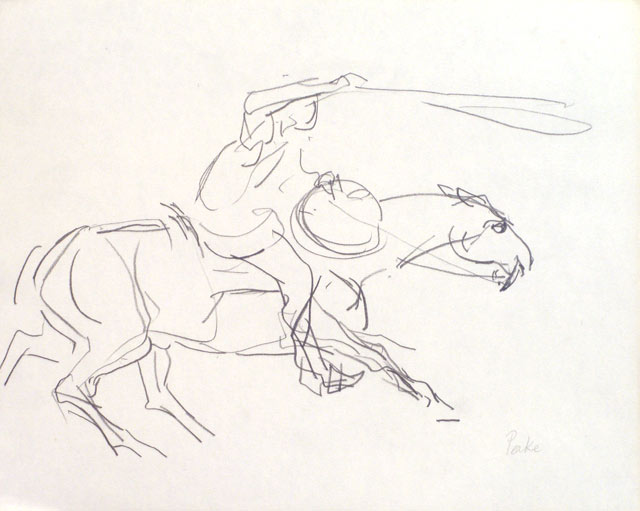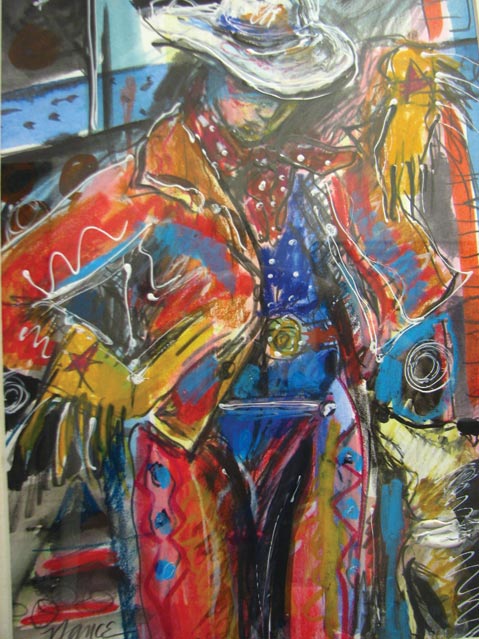Western Art at the Jewish Federation
Exhibition Focuses on Pioneers of the American West

COWBOYS AND INDIANS … AND JEWS: When Santa Barbara curator Lynn Holley began planning for her latest art exhibit at the Jewish Community Center, her question was simple: Who were Santa Barbara’s pioneering Jewish settlers? What she discovered in her research led to the rich and wide-ranging show on view at the Jewish Federation of Greater Santa Barbara (524 Chapala St.) through October 29. Don’t go expecting to see work by Jewish artists, or even work that focuses on Jewish culture. Instead, Jewish Pioneers and Contemporary Western and Historic Art takes in a broad swath of Western American art, beginning in the late 19th century, when prominent Jews like Cerf Levy were first settling in Santa Barbara, and running up to the present day. The unifying theme here is really the concept of the pioneer, whether artistic or otherwise.
The exhibition starts in the center’s community hall, where those interested in Santa Barbara’s history will find notes on the city’s early Jewish settlers, contributed by historian Erin Graffy. Nearby hang works that date from around this period and depict our region when it really was the western frontier. In “Chumash—East Beach,” a watercolor circa 1890 by Alexander Harmer, the familiar sweep of the Santa Barbara coastline is captured, its purple mountains uninterrupted by development of any kind. Children rest in the sand and paddle out into the water, and pale yellow sunshine bathes the entire scene.
Cowboys sit astride their horses on the Riviera hillside and gaze down at the Santa Barbara Mission in a finely detailed etching by celebrated cowboy artist Edward Borein. In the distance, the hills that roll down to the sea are empty, except for oak trees. This exhibition brings together four of Borein’s views of the mission never before seen together, as well as works like “Trail Herd” (c. 1930) in which a sun-baked cowhand herds a line of steer, a cigarette pursed between his thin lips.
From there, it’s a logical jump to one of the city’s pioneering contemporary artists, Channing Peake. This year would have marked Peake’s 100th birthday, and Patty Look Lewis Gallery has loaned a number of his sketches for this exhibition, including “Peake Heeling” (1980), in which the artist’s loose pencil lines capture a horse straining forward, its rider leaning in toward an invisible target, his rope caught in mid flight above his head.
That same masterful economy of line is evident in all his work, including the ink and ink wash “What Next, Peake Ranch” (1980) in which a doleful bull gazes at the viewer, and “Hang On” (1970), in which a few insistent pencil lines suffice to depict an unfortunate rodeo rider as he’s bounced upside down above his horse’s back.

It’s not all cowboys, though; contemporary collage artist Nancy Hodge focuses on cowgirls in all their glitzy, fringe-bedecked splendor, and Jeff Sojka’s oil painting “Blue and Beautiful” takes California’s golden hills and blue skies to new heights of saturated color.
There are some works by Jewish artists included: International cinematographer Charles Minsky makes his home here, and his photographs of Spanish flamenco dancers are reflections of our own Fiesta celebrations and the pride and passion that goes along with that aspect of our civic heritage. Minsky’s images complement Peter Treadwell’s large-scale photograph, “Fiesta Rider on Ledbetter Beach,” in which a sole horse and rider cut a stark and striking figure against the gray sand.
As you near the end of the hall, you’ll once more find references to the pioneering people who settled these shores long before Europeans showed up. Contemporary Native American artist Raymond Nordwall’s original monolith “Five Riders with the Moon” is a beautiful and haunting image, the horses in war paint driving forward as if to bust the surface of the print. On the facing wall hang two rare portraits of Native Americans by O.E. Berringhaus. “Old Pueblo Indian” (c. 1930) depicts its subject in profile, his wrinkled skin and furrowed brow suggesting experience we 21st-century Santa Barbarans can only dream of.



